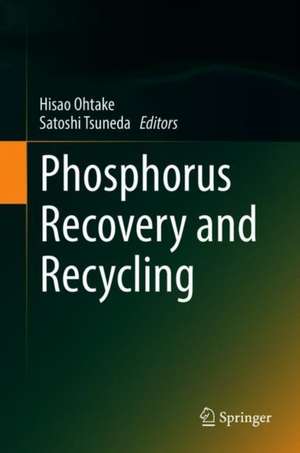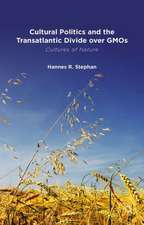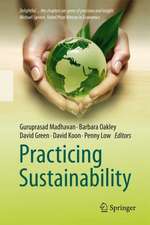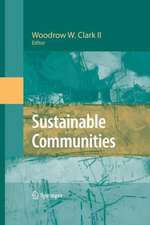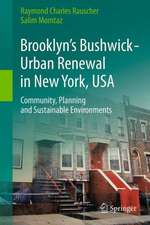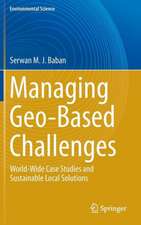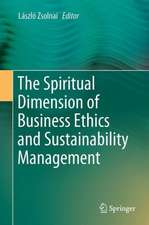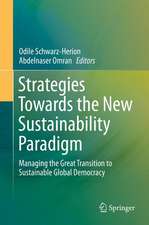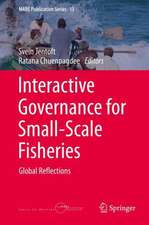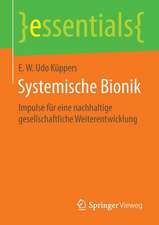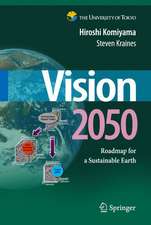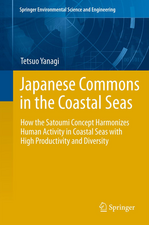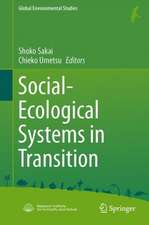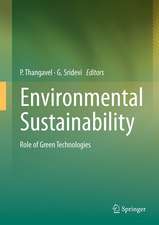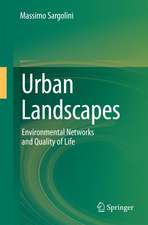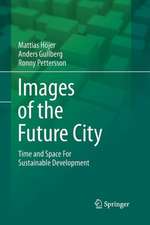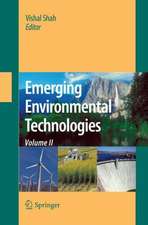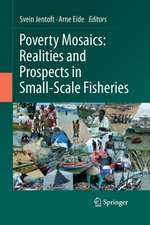Phosphorus Recovery and Recycling
Editat de Hisao Ohtake, Satoshi Tsunedaen Limba Engleză Hardback – 11 iun 2018
As an essential element for all living organisms, P cannot be replaced by any other element in biochemical processes, humans ultimately rely its availability. Today, P is mostly obtained from mined rock phosphate (Pi). However, natural reserves of high-grade rock Pi are limited and dwindling on a global scale. As such, there have been increased efforts to recycle P from secondary sources, including sewage sludge, animal manure, food waste, and steelmaking slag, and so close the anthropogenic P cycle. In addition to various aspects of phosphorus covered by other literature, including chemistry, biochemistry, ecology, soil-plant systems and sustainable management, this book is a valuable and comprehensive source of information on the rapidly evolving field of P recovery and recycling engineering for students, researchers, and professionals responsible for sustainable use of phosphorus.
| Toate formatele și edițiile | Preț | Express |
|---|---|---|
| Paperback (1) | 644.84 lei 38-44 zile | |
| Springer Nature Singapore – 29 dec 2018 | 644.84 lei 38-44 zile | |
| Hardback (1) | 1106.45 lei 3-5 săpt. | |
| Springer Nature Singapore – 11 iun 2018 | 1106.45 lei 3-5 săpt. |
Preț: 1106.45 lei
Preț vechi: 1349.32 lei
-18% Nou
Puncte Express: 1660
Preț estimativ în valută:
211.82€ • 220.18$ • 175.62£
211.82€ • 220.18$ • 175.62£
Carte disponibilă
Livrare economică 15-29 ianuarie 25
Preluare comenzi: 021 569.72.76
Specificații
ISBN-13: 9789811080302
ISBN-10: 9811080305
Pagini: 550
Ilustrații: XV, 526 p. 239 illus., 130 illus. in color.
Dimensiuni: 155 x 235 x 30 mm
Greutate: 1.03 kg
Ediția:1st ed. 2019
Editura: Springer Nature Singapore
Colecția Springer
Locul publicării:Singapore, Singapore
ISBN-10: 9811080305
Pagini: 550
Ilustrații: XV, 526 p. 239 illus., 130 illus. in color.
Dimensiuni: 155 x 235 x 30 mm
Greutate: 1.03 kg
Ediția:1st ed. 2019
Editura: Springer Nature Singapore
Colecția Springer
Locul publicării:Singapore, Singapore
Cuprins
Foreword.- Preface.- Part I Phosphorus Flow and Recycling.- 1 Development of Phosphorus Recycling in Europe and Japan.- 2 Phosphorus Flows in Asia.- 3 Circular Economy - Bridging the Gap between Phosphorus Recovery and Recycling.- 4 Life Cycle Assessment of Processes for Phosphorus Recycling.- 5 Phosphorus: Reserves, Production and Applications.- 6 Success Factors for Implementing Phosphorus Recycling Technologies.- Part II Incinerated Sludge Ash.- 7 Industrial-Scale Manufacturing of Phosphoric Acid Using Sewage Sludge Ash.- 8 Alkaline Leaching of Phosphate from Sewage Sludge Ash.- 9 Phosphorus Recovery from Sewage Sludge Ash - A Case Study in Gifu, Japan.- 10 Urban Phosphorus-Mining in the Canton Zurich: Phosphoric Acid from Sewage Sludge Ash.- 11 Calcination Technology for Manufacturing Mineral Fertilizer Using CaO-Enriched Sewage Sludge Ash.- 12 Phosphorus Recovery from Sewage Sludge by High-Temperature Thermochemical Process (KUBOTA process).- 13 Phosphorus Extraction from Sludge Ash by the CO2 blowing method.- 14 Ecophos Process.- 15 Outotec (AshDec®) Process for Phosphorus-Fertilizer from Sewage Sludge Ash.- 16 Phosphorus-Recovery into Fertilizers and Industrial Products by ICL in Europe.- Part III Sewage Sludge and Night Soil.- 17 Struvite Recovery from Digested Sewage Sludge.- 18 Phosphorus Recovery from Night Soil and Johkasou Sludge.- 19 The Stuttgart Process (Germany).- 20 Phosphorus Recovery from Wet Sewage Sludge Using CO2.- 21 Effect of Iron on Phosphorus Recovery from Sewage Sludge.- Part IV Steelmaking Slag.- 22 Phosphorus Separation and Recovery from Steelmaking Slag.- 23 Extraction of Phosphorous from Dephosphorization Slag.- 24 Phosphorus in Steelmaking Process.- Part V Animal Manure.- 25 Energy-Effective Carbonization Technology.- 26 Hydrothermal Process for Extracting Phosphorus from Animal Manure.- 27 Recovery of Calcium Phosphate from Composted Chicken Manure and Industrial Waste.- 28 OutotecManure, Slurry and Sludge Processing Technology.- 29 Bone Char as a Novel Phosphorus Fertilizer.- Part VI Solid Adsorbents.- 30 Phosphorus Recovery Using Amorphous Calcium Silicate Hydrates.- 31 High-Performance Phosphorus Adsorbent Based on Concrete Sludge.- 32 Valorisation of Nutrients in Wastewaters Using Reactive Inorganic Sorbents.- 33 Phosphate Separation from Aqueous Solution Using a Chitosan-Based Biodegradable Ion Exchanger.- Part VII Biotechnology.- 34 Biological Phosphine Oxidation and Its Application to Phosphorus Recycling.- 35 HeatPhos Process for Recovering Phosphorus from Bio-P Sludge before Anaerobic Digestion.
Notă biografică
Hisao Ohtake
Phosphorus Atlas Research Institute
Waseda University
Tokyo, Japan
Satoshi Tsuneda
Phosphorus Atlas Research Institute
Waseda University
Tokyo, Japan
Phosphorus Atlas Research Institute
Waseda University
Tokyo, Japan
Satoshi Tsuneda
Phosphorus Atlas Research Institute
Waseda University
Tokyo, Japan
Textul de pe ultima copertă
This book focuses on the engineering aspects of phosphorus (P) recovery and recycling, presenting recent research advances and applications of technologies in this important and challenging area of engineering. It highlights full-scale applications to illustrate the performance and effectiveness of the new technologies.
As an essential element for all living organisms, P cannot be replaced by any other element in biochemical processes, humans ultimately rely its availability. Today, P is mostly obtained from mined rock phosphate (Pi). However, natural reserves of high-grade rock Pi are limited and dwindling on a global scale. As such, there have been increased efforts to recycle P from secondary sources, including sewage sludge, animal manure, food waste, and steelmaking slag, and so close the anthropogenic P cycle. In addition to various aspects of phosphorus covered by other literature,includingchemistry, biochemistry, ecology, soil-plant systems and sustainable management, this book is a valuable and comprehensive source of information on the rapidly evolving field of P recovery and recycling engineering for students, researchers, and professionals responsible for sustainable use of phosphorus.
As an essential element for all living organisms, P cannot be replaced by any other element in biochemical processes, humans ultimately rely its availability. Today, P is mostly obtained from mined rock phosphate (Pi). However, natural reserves of high-grade rock Pi are limited and dwindling on a global scale. As such, there have been increased efforts to recycle P from secondary sources, including sewage sludge, animal manure, food waste, and steelmaking slag, and so close the anthropogenic P cycle. In addition to various aspects of phosphorus covered by other literature,includingchemistry, biochemistry, ecology, soil-plant systems and sustainable management, this book is a valuable and comprehensive source of information on the rapidly evolving field of P recovery and recycling engineering for students, researchers, and professionals responsible for sustainable use of phosphorus.
Caracteristici
Provides comprehensive information on P recovery and recycling, which is becoming a high-visibility topic and a rapidly evolving field of engineering Presents detailed descriptions of the principle of and technologies for P recovery and recycling Includes details of an array of full-scale applications from a variety of industrial areas
